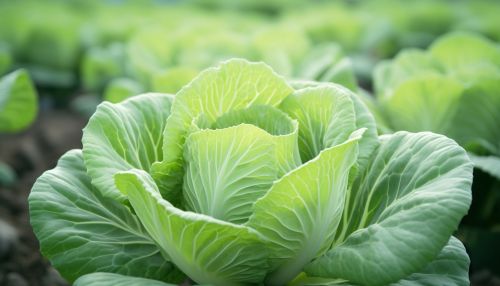Cabbage
Overview
Cabbage is a leafy green, red (purple), or white (pale green) biennial plant grown as an annual vegetable crop for its dense-leaved heads. It is a member of the genus Brassica and the mustard family, Brassicaceae. Several other vegetables in this family are also considered cabbages, such as Savoy cabbage, Napa cabbage, and Bok choy.


History
Cabbage has been cultivated for over a thousand years and has played a significant role in human diet and culture due to its adaptability to a wide range of environments and its nutritional value. The exact origins of cabbage are unclear, but it is likely that it originated in Europe and Asia before spreading to other parts of the world through trade and exploration.
Cultivation
Cabbage is a hardy, leafy vegetable full of vitamins. It can be grown in a variety of climates but prefers cooler weather. It can be grown from seed or from a small plant. Cabbage plants prefer a well-drained and fertile soil rich in organic matter.
Varieties
There are several varieties of cabbage, including green, red, and Savoy. The differences between these varieties are primarily in color and texture. Green cabbage, the most common type, has a slightly rubbery texture when raw and a mellow, almost sweet flavor when cooked. Red cabbage is similar to green, but with a slightly more peppery flavor. Savoy cabbage has a milder flavor and more tender leaves than the other types.
Nutritional Value
Cabbage is a low-calorie vegetable that is rich in vitamins and minerals. It is a good source of Vitamin C and Vitamin K. Cabbage is also high in fiber, which can help keep the digestive system healthy. The red variety of cabbage contains additional health benefits, including a concentration of anthocyanin polyphenols, which contribute to its distinctive color and offer additional nutritional benefits, such as anti-inflammatory and antioxidant properties.
Culinary Uses
Cabbage can be used in a variety of dishes and is popular in many different cuisines. It can be eaten raw, cooked, or fermented. In European and American cuisine, it is often used in salads, such as coleslaw. In German cuisine, it is commonly fermented to create sauerkraut. In Korean cuisine, cabbage is the primary ingredient used in kimchi, a spicy, fermented side dish.
Cultural Significance
Cabbage has been a staple in many cultures' diets for centuries. It has been used in traditional Chinese medicine for its supposed medicinal properties, including relief from constipation, stomach ulcers, and a variety of other ailments. In Ireland, cabbage is often associated with St. Patrick's Day and is traditionally served with corned beef.
